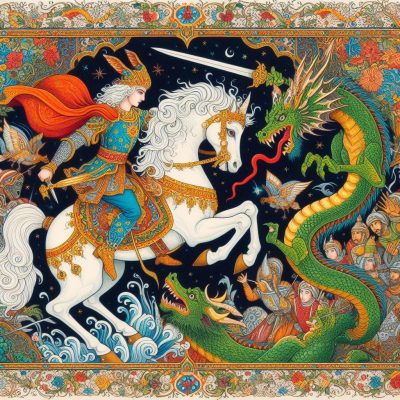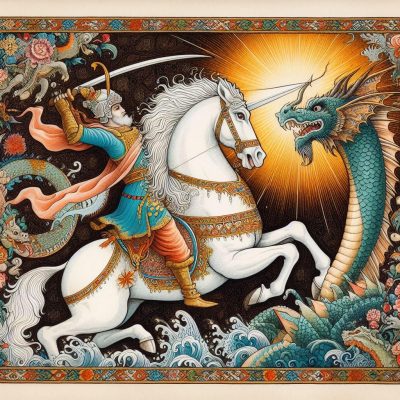Shahnameh khani is a traditional Iranian art form that involves reciting or singing the verses of Shahnameh, the epic poem written by the 10th-century poet Ferdowsi.
Shahnameh, which means “The Book of Kings”, narrates the history and mythology of ancient Persia from the creation of the world to the Islamic conquest in the 7th century. It is considered one of the masterpieces of Persian literature and a source of national pride and identity for Iranians.

Shahnameh khani is a way of preserving and transmitting the cultural heritage and values of Iran through oral performance. It is usually performed by a group of people who gather around a book of Shahnameh, either from memory or by reading from the text. The reciter or singer, called shahnameh khan, uses a special tone, rhythm, and expression to convey the emotions and meanings of the verses. The audience listens attentively and sometimes joins in the chorus or responds with praise or applause.
Shahnameh khani has been practiced for centuries in different regions of Iran, each with its own dialect, style, and musical accompaniment. Some of the most prominent styles are the Luri, the Bakhtiari, and the Kohgiluyeh and Boyer-Ahmad styles, which are named after the ethnic groups or provinces where they originated.
- The Luri style is characterized by the use of the maqam mahur, a musical mode that creates a solemn and majestic atmosphere.
- The Bakhtiari style uses the intervals of the old rast maqam, a mode that evokes a heroic and adventurous mood.
- The Kohgiluyeh and Boyer-Ahmad style employs the humayun maqam, a mode that produces a melancholic and romantic feeling.
In some border areas, such as Lordekan, a mixture of modes can be heard, reflecting the influence of both regions.
Shahnameh khani is not only a form of entertainment, but also a means of education and moral guidance. The stories and characters of Shahnameh illustrate the virtues and vices of human nature, such as courage, justice, loyalty, wisdom, love, envy, greed, and betrayal. The shahnameh khan often interprets and comments on the verses, relating them to the contemporary issues and values of the society. The audience also participates in the discussion and debate, sharing their opinions and insights.
Through shahnameh khani, the listeners learn about their history, culture, and identity, and also reflect on their own actions and choices. Shahnameh khani is a living and evolving art that adapts to the changing times and contexts. It has been influenced by other forms of storytelling, such as naqqali, which is a more dramatic and theatrical narration of Shahnameh with gestures and movements. It has also been incorporated into modern media, such as radio, television, and the internet, reaching a wider and more diverse audience.
Shahnameh khani is a valuable and unique expression of the Persian spirit and imagination, and a testament to the enduring legacy of Ferdowsi and his epic poem.

Shahnameh khani and Mazandaran culture
Mazandaran has a strong connection with Shahnameh, as it is mentioned 63 times in the epic as the Devil’s Land, a place of great Divs (demons) that no Shah ( king ) of Iran dared to conquer.
Mazandaran was also the homeland of Zal, the father of Rostam, the greatest hero of Shahnameh. Shahnameh khani is a popular and respected art form in Mazandaran, as it reflects the values and identity of the people. Mazandaranis are proud of their ancient roots and their contribution to the Iranian civilization. They also admire the courage and wisdom of the Shahnameh heroes, especially Rostam, who rescued the blinded king Kai Kavus and his army from the captivity of the White Div in Mazandaran.
Shahnameh khani is often performed in special occasions, such as weddings, festivals, and religious ceremonies, as well as in public places, such as parks, schools, and libraries. The performers and the audience wear traditional costumes and use musical instruments, such as the daf, the ney, and the tar, to create a lively and festive atmosphere. Shahnameh khani in Mazandaran has its own distinctive features, such as the use of the Mazandarani dialect, which is a branch of the Caspian languages and has many words and expressions derived from Pahlavi, the language of the Sassanid dynasty.
The Mazandarani style of shahnameh khani also incorporates elements of local folklore, legends, and proverbs, as well as references to the natural and historical landmarks of the region, such as the Elburz Mountains, the Caspian Sea, and the ancient fortresses and temples. The Mazandarani shahnameh khan is skilled in improvising and adapting the verses of Shahnameh to the context and the audience, making the performance more engaging and relevant.
Shahnameh khani in Mazandaran is a cultural treasure that deserves to be preserved and promoted. It is a manifestation of the creativity and resilience of the Mazandarani people, who have faced many challenges and hardships throughout history, such as invasions, migrations, and natural disasters. It is also a bridge between the past and the present, the local and the universal, the human and the divine. It is a reminder of the beauty and wisdom of Shahnameh, the epic that has inspired generations of Iranians and non-Iranians alike.
Shahname and Qaemshahr culture
Qaemshahr has a long and rich history of cultural and artistic activities, especially in the field of shahname khani. Qaemshahr is home to many famous shahname khans, such as Mohammad Reza Shajarian, Hossein Alizadeh, and Parviz Meshkatian, who have performed and recorded various sections of Shahnameh with their distinctive voices and musical instruments.
Qaemshahr also hosts annual festivals and competitions of shahname khani, attracting performers and audiences from all over the country and abroad. Qaemshahr’s culture is influenced by the shahname’s values of heroism, justice, loyalty, and wisdom, as well as its themes of love, war, and destiny. Qaemshahr’s people are proud of their shahname heritage and consider it a source of inspiration and identity.
conclusion
Shahnameh khani is a fascinating and valuable art form that showcases the richness and diversity of the Persian culture and literature. It is a way of celebrating and preserving the legacy of Ferdowsi and his epic poem, Shahnameh, which has influenced generations of Iranians and non-Iranians alike. Shahnameh khani is also a way of connecting with the past and the present, the local and the universal, the human and the divine. By exploring the different styles and features of shahnameh khani in various regions of Iran, especially in Mazandaran and Qaemshahr, this article has attempted to highlight the importance and relevance of this art form in the contemporary world. Shahnameh khani is not only a form of entertainment, but also a means of education and moral guidance. It is a reminder of the beauty and wisdom of Shahnameh, the epic that has inspired us to relate to the world, and the people, around us in alternative ways.
